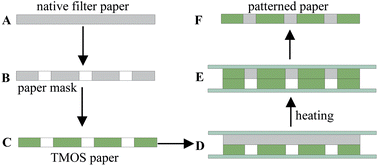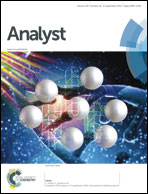Fabrication of a microfluidic paper-based analytical device by silanization of filter cellulose using a paper mask for glucose assay
Abstract
We developed a novel, low-cost and simple method for the fabrication of microfluidic paper-based analytical devices (μPADs) by silanization of filter cellulose using a paper mask having a specific pattern. The paper mask was penetrated with trimethoxyoctadecylsilane (TMOS) by immersing into TMOS-heptane solution. By heating the filter paper sandwiched between the paper mask and glass slides, TMOS was immobilized onto the filter cellulose via the reaction between cellulose OH and TMOS, while the hydrophilic area was not silanized because it was not in contact with the paper mask penetrated with TMOS. The effects of some factors including TMOS concentration, heating temperature and time on the fabrication of μPADs were studied. This method is free of any expensive equipment and metal masks, and could be performed by untrained personnel. These features are very attractive for the fabrication and applications of μPADs in developing countries or resource-limited settings. A flower-shaped μPAD was fabricated and used to determine glucose in human serum samples. The contents determined by this method agreed well with those determined by a standard method.


 Please wait while we load your content...
Please wait while we load your content...